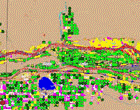CALMIT: Center for Advanced Land Management Information Technologies
Date of this Version
2007
Citation
Mishra, D. R., S. Narumalani, D. Rundquist, M. Lawson, and R. Perk (2007), Enhancing the detection and classification of coral reef and associated benthic habitats: A hyperspectral remote sensing approach, J. Geophys. Res., 112, C08014
Abstract
Coral reefs and associated benthic habitats are heterogeneous in nature. A remote sensor designed to discriminate these environments requires a high number of narrow, properly placed bands which are not currently available in existing satellite sensors. Optical hyperspectral sensors mounted on aerial platforms seem to be appropriate for overcoming the lack of both high spectral and spatial resolution of satellite sensors. This research presents results of an innovative coral reef application by such a sensor. Using hyperspectral Airborne Imaging Spectroradiometer for Applications (AISA) Eagle data, the approach presented solves the confounding influence of water column attenuation on substrate reflectance on a per-pixel basis. The hyperspectral imagery was used in band ratio algorithms to derive water depth and water column optical properties (e.g., absorption and backscattering coefficients). The water column correction technique produced a bottom albedo image which revealed that the dark regions comprised of sea grasses and benthic algae had albedo values ≈15%, whereas sand- and coral-dominated areas had albedos >30% and ≈15–35%, respectively. The retrieved bottom albedo image was then used to classify the benthos, generating a detailed map of benthic habitats, followed by accuracy assessment.
Included in
Environmental Indicators and Impact Assessment Commons, Environmental Monitoring Commons, Natural Resource Economics Commons, Other Earth Sciences Commons, Water Resource Management Commons


Comments
Copyright 2007 by the American Geophysical Union.